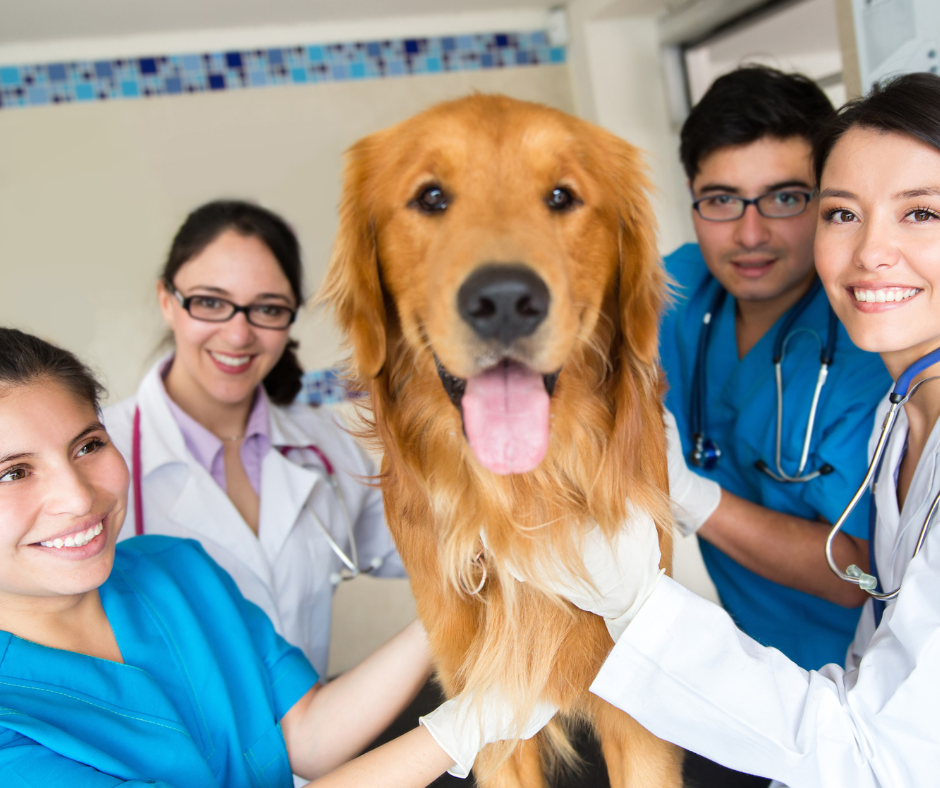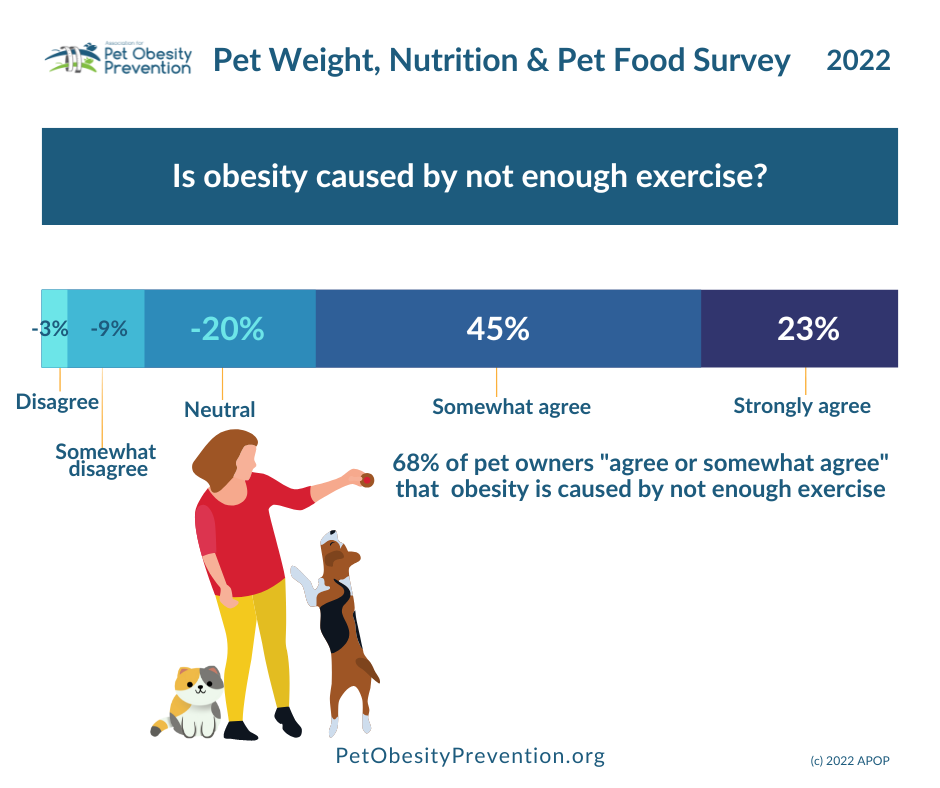
2022 Surveys & Data
2022 Pet Obesity U.S. Prevalence Survey
The 2022 Pet Obesity Prevalence Survey showed an increase in overweight and dogs and cats with obesity, with 59% of dogs and 61% of cats classified as overweight or have obesity. For dogs, this percentage increased from 56% in 2018 and 2017, and for cats a slight increase from 60%.
Consistent with previous surveys, many dog and cat owners failed to recognize excess weight or overweight body conditions in their pets. Nearly one-third (32%) of owners of overweight or pets with obesity (BCS 6-9) classified their pet as “normal,” “ideal,” or “thin” body condition when asked by their veterinary professional.
36% of dog owners considered their pet’s body condition “normal” when their veterinary professional classified it as BCS 6-9 (overweight to obesity).
28% of cat owners considered their pet’s body condition “normal” when their veterinary professional classified it as BCS 6-9 (overweight to obesity).
Click to download the 2022 State of U.S. Pet Obesity report.
Summary of Findings
Ideal weight, adiposity, body condition, and BCS represent a continuum, and any specific cutoff for disease onset is somewhat arbitrary and subjective. APOP recognizes the limitations and inconsistencies of BCS and works hard to ensure that our participating veterinary clinicians are using proper methodology and definitions.
APOP also filters the prevalence data for obvious reporting errors in our dataset. For example, if a pet is classified as BCS 5 and the reported weight, age, and breed are consistent with an overweight or animal with obesity, that figure is adjusted accordingly. In our 19 prevalence surveys, this figure can vary between 8 and 12% of all entries. The 2022 survey showed approximately 10% obvious reporting errors, with feline BCS 8-9 (obesity) being the most frequently underreported value as a BCS of 7 to 8 (overweight).
The increase in pet dogs (dogs owned as opposed to feral or free-roaming) classified as overweight or with obesity may be attributed to improved clinical assessments, results of pandemic-related inactivity or overfeeding, aging dog populations, variations in sample size and distribution, or other unknown influences. Because the relative changes were consistent, and the distribution of pet dogs with obesity increased, we have high confidence in these results.
Canine body mass spans nearly 40-fold from largest to smallest breeds, making consistent BCS assessments challenging. Further compounding accurate BCS assessment is varying canine coat types, making BCS in dogs with long or thick fur less precise than desired.
There are promising technological and laboratory solutions to measure body fat percentages in companion animals, and we are working to bring these developments to veterinary professionals.
The prevalence of pet cats (cats owned as opposed to feral or free-roaming) classified as overweight or with obesity is relatively unchanged from 2018 and 2017. The slight increase in pet cats classified as overweight suggests more precise clinical BCS assessments, particularly in cats exceeding ideal weight or body condition by one to two pounds.
Accurately assessing feline BCS can be difficult, especially in cats with prominent primordial pouches (“belly flaps”) or long hair. Because the subjective BCS difference between “overweight” and “obesity” can be minimal, APOP is working to create improved methods for measuring body condition and body fat in pet cats.
The Association for Pet Obesity Prevention’s surveys provide key insights into obesity and nutrition trends among U.S. dogs and cats. This report highlights Body Condition Score data, obesity prevalence rates, and weight management practices to help veterinarians, researchers, and pet owners improve pet health and prevent obesity.
2022 Pet Obesity and Nutrition Survey Results
Pet Owner Perception of Body Condition
Nearly one-third (32%) of owners of overweight or obese pets (BCS 6-9) classified their pet as “normal,” “ideal,” or “thin” body condition when asked by their veterinary professional.
Consistent with our previous surveys, many dog and cat owners fail to recognize excess weight or overweight body conditions in their pets. The question was presented before being told their pet’s current weight or BCS.
36% of dog owners considered their pet’s body condition “normal” when their veterinary professional classified it as BCS 6-9 (overweight to obesity).
9% of owners of dogs with obesity (BCS 8-9) classified them as having “normal body condition.”
28% of cat owners considered their pet’s body condition “normal” when their veterinary professional classified it as BCS 6-9 (overweight to obesity).
7% of owners of cats with obesity (BCS 8-9) classified them as having “normal body condition.”Client Perception of Pet Body Condition
Do veterinarians discuss healthy weight?
49% of respondents reported that their veterinary professionals discussed their pet’s ideal or healthy weight yearly, compared to 46% in 2021.
This figure has remained consistent between 46% to 53% during our survey periods.
Have you ever felt uncomfortable or embarrassed about a veterinarian or veterinary team member saying your pet needs to lose weight?
Two-thirds (67%) of pet owners surveyed said they “have not felt embarrassment or uncomfortable after being told their pet needed to lose weight.”
Only 17% reported “feeling uncomfortable or embarrassed when told their pet needed to lose weight.”
15% of respondents said their pet has never needed to lose weight.
While these results may be biased toward pet owners interested in pet nutrition and obesity, our results indicate they are interested in being told about their pet’s body condition and need for weight loss. Veterinarians often remark that pet owners will be embarrassed or even angry if told their pet has obesity or needs to lose weight. Further research is required to determine if this is true. Until then, veterinary professionals should ask clients for permission and interest in discussing their pet’s body condition or weight loss and proceed accordingly.
Pet Weight Loss Strategies, Attempts, & Success Rates
Have you ever tried to help your pet lose weight?
73% of dog owners and 58% of cat owners stated they had tried some form of pet weight loss
Most surveyed pet owners reported they had tried to help their pets lose weight. The difference between cat and dog weight loss efforts may be attributable to factors such as being able to exercise a dog through walks or outdoor physical activities, the ability to perceive weight gain more easily on a canine, or familiarity with breed standards and morphology.
In addition, there may be more confident communication from veterinary professionals on canine body composition and weight loss strategies due to more precise educational resources such as body condition charts and diet choices.
There may also be unique communication barriers between veterinary professionals and feline owners associated with weight bias and stigma. Finally, it can be difficult to determine feline body fat percentages based on visual and tactile information.
Pet Weight Loss Success Rates
We asked pet owners who tried to help their pets lose weight to rate their success. Dog owners reported higher “success” or “some success” rates than cat owners.
“Success” in helping their pet lose weight was reported by 34% of dog owners and 19% of cat owners
“Some success” was noted by 26% of dog and 34% of cat owners
“Gained back the weight” was said by 12% of dog and 5% of cat owners
“No success” or “My pet did not lose weight despite my best effort.” was reported by 23% of dog and 29% of cat owners
Nearly half of the surveyed pet owners declared some weight loss for their dog or cat when they tried. While this figure is encouraging, it must be noted that this is a self-reported finding and does not indicate a permanent, meaningful, or actual weight loss was achieved. More importantly, it may suggest that pet owners believe they can successfully help their pets lose weight.
Use of Therapeutic Weight-Loss Diets
Therapeutic pet weight loss diet (“prescription diets") usage remains at the bottom of our pet owner rankings in both pet loss methods and perceived efficacy. These findings are consistent with our findings in 2018, when 19% of pet owners stated they had tried a therapeutic weight loss diet to help their pets lose weight.
Therapeutic weight loss diets are the primary evidence-based treatment veterinary professionals have to help an overweight pet attain a healthy body composition. The fact that only about one in five owners of overweight pets in our survey reported they have tried a therapeutic weight loss diet indicates a gap in education and compliance.
Additional barriers to treatment may include perceived higher costs associated with some therapeutic diets, lack of easy access to certain brands or formulations, changes in fecal output or other physical factors during diet transition, and lack of significant or timely improvement.
Low therapeutic weight loss diet use may also result from a lack of veterinary healthcare recommendations for overweight dogs and cats (BCS 6-7). Veterinary professionals may be hesitant to advise changing diets for a variety of reasons, including cost, incapacity to support or monitor a weight loss plan, lack of understanding of the health risks of being overweight, widespread nutritional misinformation and confusion, or negative client perception of “vets selling food”.
Likert Scale Questions: Causes of Pet Obesity, Exercise, Willpower, and Blame
This year a series of questions were asked in a Likert Scale format to help determine pet owners’ opinions on the causes of pet obesity.
A Likert scale is a commonly used psychometric tool for measuring people's attitudes, opinions, and perceptions providing a structured method of gathering data on the strength of feelings about a subject and in this survey, feelings around the causes of pet obesity, blame and willpower. There were five response choices: Strongly Disagree, Disagree, Neutral, Agree, and Strongly Agree.
The first question we investigated was whether or not pet owners thought obesity was a result of overfeeding.
Is pet obesity a result of overfeeding?
Using a Likert scale analysis, 73% of pet owners somewhat or strongly agreed that pet obesity resulted from overfeeding
34% reported “strongly agree”
39% “somewhat agree”
Is pet obesity caused by poor feeding choices?
70% of survey respondents “somewhat agreed” (41%) or “strongly agreed” (29%) that poor feeding choices cause pet obesity
17% answered “neutral”
13% “somewhat disagreed” or “disagreed”
Is pet obesity a result of a biological disorder?
43% of pet owners were “neutral”
35% answered “somewhat agree”
25% “strongly agree”
14% answered “somewhat disagree”
6% “disagree”
Do you believe pet obesity is caused by inadequate exercise?
68% of our respondents “agreed” or “somewhat agreed” that obesity is caused by “not enough exercise.”
20% were “neutral”
12% “somewhat disagreed” or “disagreed”
We explored the concept of willpower in causing pet obesity. Lack of willpower is cited as a cause or contributor to human weight gain. While we disagree with this rationale, veterinary clients often mention a lack or loss of willpower when asked why they discontinued a pet weight loss program.
Do you believe overfeeding or giving excess treats is caused by a lack of a pet owner’s willpower?
32% “strongly agreed”
30% “somewhat agreed”
23% were “neutral”
15% “somewhat disagreed” or “disagreed”
Do pet owners have themselves to blame for an overweight or obese pet?
32% of pet owners surveyed reported they “strongly agree” that pet owners are to blame for an overweight or obese pet.
30% “somewhat agreed”
23% were “neutral”
8% “somewhat disagreed”
7% “disagreed”


















